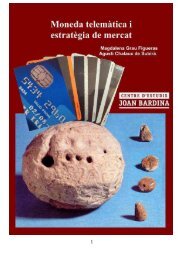Telematic currency and market strategy (mtemuk.pdf). - Centre d ...
Telematic currency and market strategy (mtemuk.pdf). - Centre d ...
Telematic currency and market strategy (mtemuk.pdf). - Centre d ...
You also want an ePaper? Increase the reach of your titles
YUMPU automatically turns print PDFs into web optimized ePapers that Google loves.
While at the beginning anybody with sufficient authority <strong>and</strong> riches could mint his own coins, at a later date<br />
this function became an exclusive monopoly of official bodies.<br />
It is easy to underst<strong>and</strong> that when the use of metallic money becomes general, one of the basic characters of<br />
the primitive money instruments is lost: documentation.<br />
In every mercantile operation the only function of metallic money is to be a paying means, that is an<br />
instrument which allows a good transaction to be made. By delivering some coins, any situation of <strong>market</strong><br />
exchange can be considered as paid <strong>and</strong> settled.<br />
6. From metallic money to paper money.<br />
Metallic money spread quickly <strong>and</strong> was well accepted by all the civilized peoples of antiquity. However, its<br />
own nature held the seed of its obsolescence.<br />
In fact, metallist systems have a very precise limitation to their development: the quantity of minting metal in<br />
every geo-political society at any given time. This limitation is so precise, that soon it became apparent that<br />
the systems of metallic <strong>and</strong> concrete money had to be discarded to go back little by little to money systems<br />
whose character was an absolute abstraction.<br />
As we have already said several times, money systems are abstract constructions with the function of making<br />
the exchange of real goods easier, because of their evaluation. These abstract constructions are simple images<br />
of the real goods exchanges <strong>and</strong> must circulate simultaneously, evolving <strong>and</strong> being adapted to them. When<br />
this adaptation does not happen spontaneously, it becomes necessary to introduce an appropriate monetary<br />
<strong>strategy</strong>: the invention of money.<br />
In a regime of metallic money this <strong>strategy</strong> becomes impossible. In fact the philosopher's stone which<br />
transforms any metal in gold has not yet been discovered, therefore it is not possible to increase at will the<br />
existence of monetary metal when it is insufficient for the quantity of goods on the <strong>market</strong>.<br />
Every time a <strong>market</strong> becomes in excess dynamic <strong>and</strong> productive, the lack of minting metal causes new sorts<br />
of monetary instruments to appear, less limited in their possibility of expansion.<br />
Historically, bankers have been originators -<strong>and</strong> main beneficiaries, even if not the only ones- of these new<br />
forms of money, more <strong>and</strong> more abstract <strong>and</strong> far from the reality <strong>and</strong> intrinsic value of metallic money.<br />
Let us see now, very shortly, the history of this return to the necessary abstraction of the money system,<br />
which is not definitely reached until 1914.<br />
Already in the Middle Ages, in Europe, the shortage of precious metals urged kings <strong>and</strong> other minting<br />
authorities to effect money manipulations either secretly or publicly. Since the coinage <strong>and</strong> legal circulation of<br />
money were in their h<strong>and</strong>s, these authorities could make the face <strong>and</strong> legal value of the coins not to<br />
correspond to the actual value of the metal. This could be done in two different ways: by minting new coins<br />
with the same face value but with a lower contents of metal; or oficially <strong>and</strong> artificially increasing the face<br />
value of the pieces in circulation. This way, the minting authority could effect payments using a smaller<br />
quantity of metal. These proceedings were ordinary practice during the whole of the Low Middle Ages, when<br />
royal treasuries were almost permanently indebted <strong>and</strong> could solve their problems with this monetary<br />
stratagem.<br />
But this solution was short lived, as the logic consequence of the manipulations was the increase of prices <strong>and</strong><br />
salaries; an increase which produced a new difficulty to the treasury, which was compelled to effect new<br />
manipulations, starting an endless cycle. Of course the ones to suffer more were always the lower classes,<br />
who had not enough buying power to face the price increases, <strong>and</strong> who could not manipulate the money<br />
which was imposed on them.<br />
22



